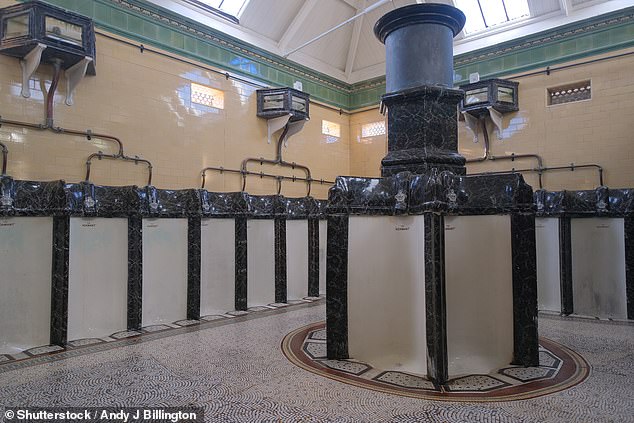You don’t have to spend a penny to visit the highest-rated historic site on Tripadvisor for the Scottish seaside town of Rothesay… But you can if you need to.
Incredibly, the top-ranked ancient landmark in the capital of the Isle of Bute is a Victorian toilet block on Rothesay’s beachside esplanade.
To date, more than 500 travellers have submitted reviews of the town’s public conveniences, giving it an overall 4.5 out of 5 rating. Reviews range from ‘exquisite’ to ‘amazing’. One called them ‘the most wonderful cisternal decoration this side of Rome’, another ‘the most impressive public conveniences in Britain’.
I visited the Isle of Bute to discover why this toilet block has become such an internet sensation.
Bus tours of Bute that previously headed to conventional attractions, like Mount Stuart stately home and gardens and the medieval Rothesay Castle, now stop to see the toilets.

On Tripadvisor, the top-ranked ancient landmark in Rothesay, the capital of the Isle of Bute, is this Victorian toilet block. Simon Heptinstall visited to see why it has become such an internet sensation


To date, more than 500 travellers have submitted reviews of Rothesay’s public conveniences, giving it an overall 4.5 out of 5 rating. Reviews range from ‘exquisite’ to ‘amazing’
The island sits at the mouth of the Firth of Clyde in southwest Scotland. It’s about two hours’ drive from Glasgow, including a 40-minute ferry.
Visitors disembark on the seafront at Rothesay, the only town on the island. It’s a classic small Victorian seaside resort with ornamental gardens and palm trees on the promenade.
With its beaches, hotels and cafes, Bute was a popular destination for Victorian steamboat trippers. Many men are said to have spent the journey drinking heavily in the unregulated bar on board, hence the phrase ‘steaming drunk’.
Perhaps that’s why the toilet block stands right next to the slipway to the ferry, between a miniature putting green and ornamental fountains and flowerbeds. Today, it’s open daily and free.

One reviewer called the Victorian toilets ‘the most wonderful cisternal decoration this side of Rome’

The opulent urinals were visited by King Charles when he was Prince of Wales
You’ll spot the simple brick block by its wrought iron period sign saying ‘public conveniences’. You wouldn’t think it was anything other than a handy facility on the waterfront.
But stepping inside is like going back in time. There’s an attendant’s cubicle and a tiled lobby with displays about the craftsmen who created the toilet fittings. There’s even a visitors’ book, surely the only one in a toilet anywhere in the world.
A heavy brown wooden door with period etched glass saying ‘lavatory’ pushes open to reveal Britain’s most extraordinary gents.
It’s a large room with a beautiful mosaic floor and a high-pitched wooden ceiling with skylights. Around the walls are 20 of the most ornate black-marble-and-white porcelain urinals you’ll ever see. Each has two black-and-white tiled footstands, a distinctive Victorian Twyford’s badge and the words ‘The Adamant’ printed into the porcelain.


Architectural historians consider the Rothesay loos the finest surviving Victorian public toilets in Britain. They were built in 1899 by the Rothesay Harbour Trust for the princely sum of £530 using the finest possible fittings supplied by Twyford of Glasgow, writes Simon
In the centre of the room is a round podium of six more opulent marble urinals. The plumbing is fed by high wall-mounted cisterns of black marble and glass, showing the water level within. The walls are all tiled, the pipework is shiny polished copper, and period lights hang from the ceiling. Hand basins are made of Wedgewood blue veined porcelain and above them, a decorated dado rail of fancy tiles.
It’s no wonder architectural historians consider these the finest surviving Victorian public toilets in Britain.
The opulent urinals have even been visited by King Charles when he was Prince of Wales. The urinal he used is now surely the only one in the world marked with his coat of arms and the phrase ‘by Royal Appointment’.
The toilets were built in 1899 by the Rothesay Harbour Trust for the princely sum of £530 using the finest possible fittings supplied by Twyford of Glasgow. Amazingly, when the block was built, ladies were not expected to use public lavatories at all. It was thought that a lady should simply wait until she returned to the privacy of her home.
That’s why the gentlemen’s toilets are Victorian. The female toilets were added in 1994 – in storage rooms. They are completely ordinary.
Today’s female visitors, however, can ask the attendant to knock on the door before taking a look. If there’s nobody on duty, they simply have to risk peeping inside the gents to see the unique ornamentation.
More info: visitbute.com.
This article was originally published by a www.dailymail.co.uk . Read the Original article here. .

